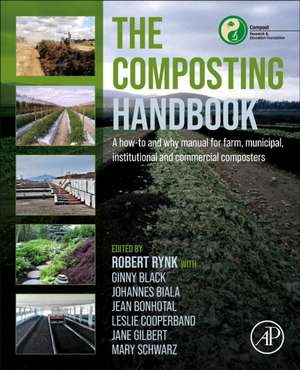The Composting Handbook: A how-to and why manual for farm, municipal, institutional and commercial composters
Editat de Robert Rynk, Ginny Black, Jane Gilbert, Johannes Biala, Jean Bonhotal, Mary Schwarz, Leslie Cooperbanden Limba Engleză Paperback – 8 dec 2021
Composting is a well-established and increasingly important method to recycle and add value to organic by-products. Many, if not most, of the materials composting treats are discarded materials that would otherwise place a burden on communities, industries, farms and the environment. Composting converts these materials into a valuable material, compost, that regenerates soils improving soils for plant growth and environmental conservation.
The Composting Handbook expands on previously available resources by incorporating new information, new subjects and new practices, drawing its content from current scientific principles, research, engineering and industry experience. In both depth and breadth, it covers the knowledge that a compost producer needs to succeed. Topics include the composting process, methods of composting, equipment, site requirements, environmental issues and impacts, business knowledge, safety, and the qualities, uses and markets for the compost products.
The Composting Handbook is an invaluable reference for composting facility managers and operators, prospective managers and operators, regulators, policy makers, environmental advocates, educators, waste generators and managers and generally people interested in composting as a business or a solution. It is also appropriate as a textbook for college courses and a supplemental text for training courses about composting or organic waste management.
- Created in conjunction with the Compost Research and Education Foundation (CREF)
- Includes the latest information on composting and compost, providing the first comprehensive resource in decades
- Written with focus on both academic and industrial insights and advances
Preț: 596.44 lei
Preț vechi: 764.13 lei
-22% Nou
Puncte Express: 895
Preț estimativ în valută:
114.13€ • 119.40$ • 94.81£
114.13€ • 119.40$ • 94.81£
Carte tipărită la comandă
Livrare economică 27 martie-10 aprilie
Preluare comenzi: 021 569.72.76
Specificații
ISBN-13: 9780323856027
ISBN-10: 0323856020
Pagini: 1002
Ilustrații: 275 illustrations (250 in full color)
Dimensiuni: 191 x 235 x 59 mm
Greutate: 1.69 kg
Editura: ELSEVIER SCIENCE
ISBN-10: 0323856020
Pagini: 1002
Ilustrații: 275 illustrations (250 in full color)
Dimensiuni: 191 x 235 x 59 mm
Greutate: 1.69 kg
Editura: ELSEVIER SCIENCE
Cuprins
1. Why Compost?
2. Enterprise Planning
3. The Composting Process
4. Compost Feedstocks
5. Passively Aerated Composting Methods, Including Turned Windrows
6. Forced Aeration Composting, Aerated Static Pile, and Similar Methods
7. Contained Composting Methods and Methods Summary
8. Composting Animal Mortalities
9. Compost Operations and Equipment
10. Site Planning, Development, and Environmental Protection
11. Process Management
12. Odor Management and Community Relations
13. Safety and Health Principles and Practices
For Composting Facilities
14. Facility Management
15. Compost Quality and Testing
16. Compost Use
17. Compost Use for Plant Disease Suppression
18. Compost Marketing and Sales
19. Composting Economics
2. Enterprise Planning
3. The Composting Process
4. Compost Feedstocks
5. Passively Aerated Composting Methods, Including Turned Windrows
6. Forced Aeration Composting, Aerated Static Pile, and Similar Methods
7. Contained Composting Methods and Methods Summary
8. Composting Animal Mortalities
9. Compost Operations and Equipment
10. Site Planning, Development, and Environmental Protection
11. Process Management
12. Odor Management and Community Relations
13. Safety and Health Principles and Practices
For Composting Facilities
14. Facility Management
15. Compost Quality and Testing
16. Compost Use
17. Compost Use for Plant Disease Suppression
18. Compost Marketing and Sales
19. Composting Economics
